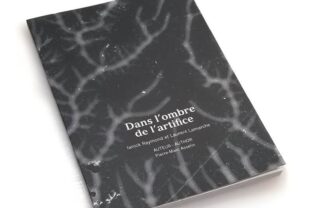Federico Carbajal
Janus Redux

It all depends how you look at it. Federico Carbajal is a visual conjurer whose works flirt with several disciplines, from sculpture to anatomy. For this exhibition, the Mexican-born artist brings together works from four distinct series: Bipolar Asymmetries, Wireheads and Portrait Shadows and the latest, eponymous Dissecting Thoughts. All play with the idea of polarity, duality, the enigma of movement changing shapes, with the underlying vision of illustrating, materializing, different states of mind. And all done with a seductive twist of metal.
The eponymous series takes on this task head on (no pun intended), focusing on the human face/head in a state of flux. This is achieved with the aid of the material Carbajal chose for this production: metres of interlaced steel and copper wire.
The aesthetic of these “woven” sculptures is as ambiguous as their designation. Stylized, deceptively simple, they depict the human head as an open circuit, with the greatest economy of means. The copper wire adds a beautiful touch of colour to the otherwise austere works. These busts are like a riff on classical sculpture but with an in-your-face contemporary, quasi-technological twist. Not quite robotic, these sculptures nevertheless speak of the matrix more than of antiquity.
And yes, the magic lies in the way one looks at them… Each angle offers a different view of the head, changing its expression and the viewer’s perception.
The exhibition features a couple of works that are projected onto the wall, giving yet another appreciation, from intriguing to macabre. When turned a certain way, the head looks like it’s screaming, change your focus and all you see is quiet features emanating from a tangle of wires. Part of the Portrait Shadows installation, they hark at drawing when projected, thus bringing in another discipline Carbajal so astutely incorporates into his oeuvre.
For the Bipolar Asymmetries series, the artist chose to place his wire portraits within a circular plexiglass frame, bolted with giant screws that add a mechanical touch to the composition. Ostensibly speaking of the dichotomy that marks our reality, be it physical or mental, these transparent medallions brings to mind the Roman god Janus. Depicted as having two faces, he presides over beginnings, duality, passages, endings… and all of which can be garnered from Carbajal’s deceptively filigree works.
Wireheads is the most sculptural of the productions in this stylized exhibition, presenting three-dimensional interconnected heads, compositions that literally turn viewing them on its head. Like an illustration to the saying of “being of two minds”, these works dance between the figurative and the abstract, all the time staying within the confines of Carbajal’s distinct visual expression.
For the artist, this is “an exploration into the boundaries of space: volume, surface and line; of the immaterial form and its perception.” His fascination with the human body and its anatomy leads him to the question of “the appropriation of its symbols,” and in that moment his art takes on a more profound discourse. Artists have used the human form from time immemorial, and Carbajal’s exploration falls in with some of the greatest artists of our times.
It should be noted that Carbajal has a Master’s degree in architecture, which he still practices, and that he went on to study sculpture under the guidance of sculptor Holton Rower, grandson of the renowned sculptor Alexander Calder. All these influences have invested the artist’s particular style and choice of medium, they have not, however, interrupted his personal visual and philosophical quest.
Federico Carbajal Dissecting Thoughts
Galerie Dominique Bouffard
May 18—June 18, 2017





